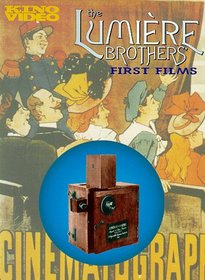| Genres: Action & Adventure, Documentary Sub-Genres: Action & Adventure, Biography Studio: Kino Video Format: DVD - Black and White,Color DVD Release Date: 09/02/2003 Release Year: 2003 Run Time: 1hr 1min Screens: Black and White,Color Number of Discs: 1 SwapaDVD Credits: 1 Total Copies: 0 Members Wishing: 8 MPAA Rating: NR (Not Rated) Languages: English |
Search - Lumiere Brothers First Films on DVD
  | Lumiere Brothers First Films Genres: Action & Adventure, Documentary NR 2003 1hr 1min Eighty-five of the silent 50-second "actualities" made by the Lumieres between 1895 and 1897 have been mastered from original 35mm material and are presented here in this first ever authorized video presentation. An amazin... more » |
Larger Image |
Movie DetailsSimilar Movies
|
Movie ReviewsTREASURE!!! rkass | Boston, MA | 10/24/1999 (5 out of 5 stars) "Imagine seeing beautiful moving images from the 1890's! It's fascinating to see the buildings, clothing, and vehicles of the time. The prints are very clear, and the commentary by Bertrand Tavernier is amusing. This is clearly a production that was made with care and love.I'm submitting this review in the hope that sales of this wonderful disc will increase, allowing Image Entertainmment and Kino Video to continue to produce such treasures." Great, but not perfect rkass | 05/31/2000 (4 out of 5 stars) "What a wonderful and fun DVD! The images are fascinating, the narration is delightful and informative, but there is one annoying problem. Many times throughout they make reference to the 50 second length of all the films, but, unfortunately, on this recording they only last 40 seconds BECAUSE THEY WERE RECORDED AT THE WRONG SPEED! The Chapter numbers also don't match up with the table of contents. But over all, this is a very worthwhile and enjoyable DVD." This DVD simplier documents the birth of the motion picture Lawrance M. Bernabo | The Zenith City, Duluth, Minnesota | 09/11/2001 (5 out of 5 stars) "If you are a true student of cinema and have any sort of affection for the early pioneers, then you have to add this DVD to your collection. "The Lumiere Brother's First Films" presents 85 of the films the brothers made 1895-97, all lasting under a minute in length. The Lumiere Institute restored each of these gems from the original 35mm film, which cover the tremendous breadth of their work, from their first dolly shot to their recording history in countries around the world. The films are narrated by Bertran Tavernier, President of the Lumiere Institute. Now if somebody would do the same thing for Edison, Melies and the other pioneers of film, I would be even happier. This DVD was released in 1996, the same year that 40 international filmmakers such as David Lynch, Spike Lee, Zhang Yimou were allowed to make their own one-minute Lumiere films using the restored original camera for "Lumiere & Company." Not as important as this collection, but certainly an interesting tribute." Fascinating look at some of the world's first films calvinnme | 01/26/2007 (5 out of 5 stars) "Antoine Lumière, the father of Auguste and Louis, saw a demonstration of Edison's Kinetoscope invention in Paris. When he came home he described the impressive device to his sons and told them that he thought they could do even better. Thus, the two brothers began work on their own camera device and proved their father correct. The Lumiere brothers' device was mobile, unlike Edison's Kinetoscope. Thus it could be moved about to make films of real life in progress. Their camera produced less jitter in the resulting films, thus allowing the brothers to experiment with different film techniques. In 1895 they began putting their invention to work filming employees passing through the front gate of the family business. In these early day, the Lumières as well as Edison, were likely to film what we would describe today as "home movies" since the idea of the feature film really hadn't even been born yet. For the next two years the brothers continued experimenting with their device, and filmed over 1500 "actualities". This collection contains 85 of those short films, each 50 seconds long.
The narrator of this set is Bertrand Tavernier, and he knows the Lumières work specifically the way Robert Osborne knows cinema in general. Thus he is able to add all kind of insightful comments. According to Tavernier, the Lumières weren't just carrying their camera out to interesting locales and shooting films. They were also looking for interesting ways to present images on film. Since Louis was an experienced photographer before the brothers built and began experimentng with their own device, he was able to incorporate his talent into their work with the motion picture. For example, "Train arrival in the station of La Ciotat" is more than just a documentation of passengers embarking and disembarking a train. There is also a sense of perspective and depth that makes the little "actuality" special and artistic. In "Carnaux: Taking out of the coke oven" there are factory workers on different levels and at different depths all going about their separate tasks that makes the image very interesting to behold. The Lumieres use a similar technique in ""Washerwomen on the river". Besides doing an excellent job of documenting everyday life while demonstrating interesting motion picture techniques, the Lumieres were also capable of producing very amusing little comedies. In "Mechanical delicatessen trade" a pig is shown being loaded into one end of a box. After the workers turn a large wheel attached to the box, they open the other side and remove sausages. This still proves amusing over a hundred years later to almost everyone except vegetarians. I highly recommend this DVD set as a way to familiarize yourself with Edison's French contemporaries and fellow pioneers in the art of cinema. You have to be interested in the art and history of film to really appreciate it, though." |




